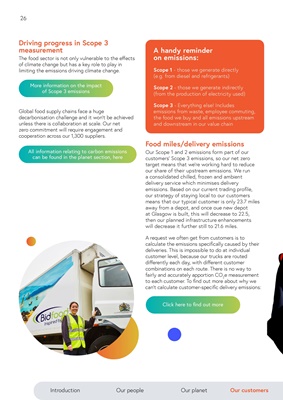
26
Introduction Our people Our planet
Driving progress in Scope 3
measurement
The food sector is not only vulnerable to the effects
of climate change but has a key role to play in
limiting the emissions driving climate change.
More information on the impact
of Scope 3 emissions
Global food supply chains face a huge
decarbonisation challenge and it won't be achieved
unless there is collaboration at scale. Our net
zero commitment will require engagement and
cooperation across our 1,300 suppliers.
All information relating to carbon emissions
can be found in the planet section, here
Food miles/delivery emissions
Our Scope 1 and 2 emissions form part of our
customers' Scope 3 emissions, so our net zero
target means that we're working hard to reduce
our share of their upstream emissions. We run
a consolidated chilled, frozen and ambient
delivery service which minimises delivery
emissions. Based on our current trading profile,
our strategy of staying local to our customers
means that our typical customer is only 23.7
miles away from a depot, and once Glasgow
depot is built, this will decrease to 22.5, then
our planned infrastructure enhancements
will decrease it further still to 21.6 miles.
A question that customers often ask us is to
calculate the emissions specifically caused by their
deliveries. This is impossible to do at individual
customer level, because our trucks are routed
differently each day with different customer
combinations on each route. There is no way to
fairly and accurately apportion CO2e measurement
to each customer. To find out more about why we
can't calculate customer-specific delivery emissions:
A handy reminder
on emissions:
Scope 1 - those we generate directly
(e.g. from diesel and refrigerants)
Scope 2 - those we generate indirectly
(from the production of electricity used)
Scope 3 - Everything else! Includes
emissions from waste, employee commuting,
the food we buy and all emissions upstream
and downstream in our value chain
Click here to find out more
Our customers